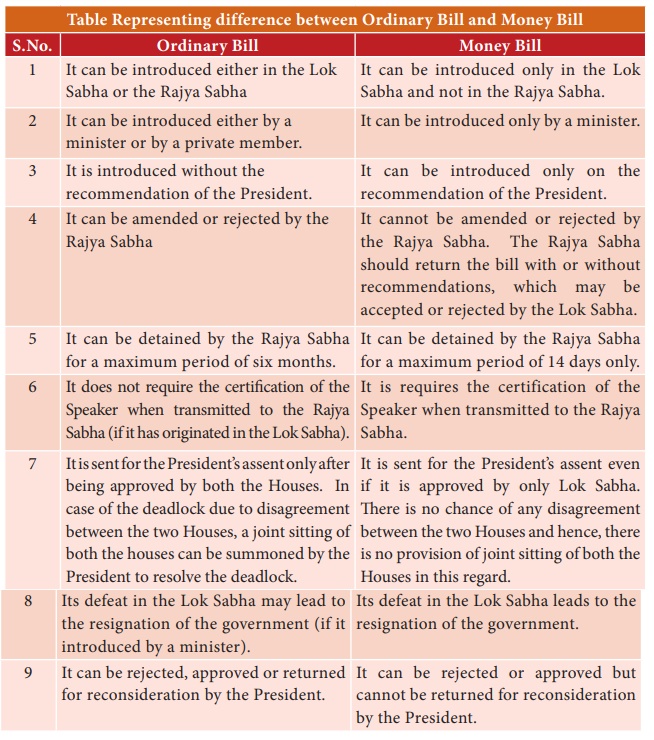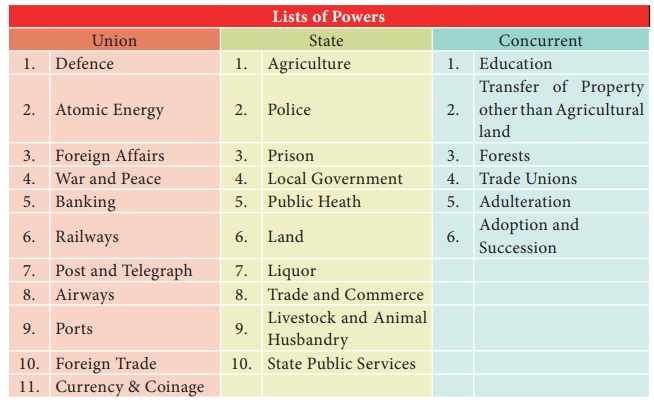India Legislature | Political Science - Distribution of powers of the legislature | 12th Political Science : Chapter 2 : Legislature
Chapter: 12th Political Science : Chapter 2 : Legislature
Distribution of powers of the legislature
Distribution of powers of the legislature
The legislative powers and functions of the Union
and the States are clearly demarcated in seventh schedule of the Constitution
of India. The powers on which both union and the states can legislate is
clearly defined. The Constitution has classified the subjects for which the
legislation can be made to perform the duties and responsibilities with
specific powers for division of powers to avoid the seventh schedule of the
constitution which provides for trifurcation of legislative powers;
1. The Union List
2. The State List and
3. The Concurrent List
The Union List includes the subjects over which the
parliament has exclusive authority to make laws and change the existing laws.
The State Legislature has exclusive authority over subjects mentioned in the
state list. In the subjects enumerated in the ‘Concurrent List’ both the Union
and the States can legislate. In the event of contradictions between the Union
and States, the Union’s authority will prevail. The residuary power is vested
in the Centre.


Table Representing difference between Ordinary Bill and Money Bill
Ordinary
Bill
1. It can be introduced either in the Lok Sabha or
the Rajya Sabha
2. It can be introduced either by a minister or by
a private member.
3. It is introduced without the recommendation of
the President.
4. It can be amended or rejected by the Rajya Sabha
5. It can be detained by the Rajya Sabha for a
maximum period of six months.
6. It does not require the certification of the
Speaker when transmitted to the Rajya Sabha (if it has originated in the Lok
Sabha).
7. It is sent for the President’s assent only after
being approved by both the Houses. In case of the deadlock due to disagreement
between the two Houses, a joint sitting of both the houses can be summoned by
the President to resolve the deadlock.
8. Its defeat in the Lok Sabha may lead to the
resignation of the government (if it introduced by a minister).
9. It can be rejected or approved but cannot be
returned for reconsideration by the President.
Money
Bill
1. It can be introduced only in the Lok Sabha and
not in the Rajya Sabha.
2. It can be introduced only by a minister.
3. It can be introduced only on the recommendation
of the President.
4. It cannot be amended or rejected by the Rajya
Sabha. The Rajya Sabha should return the bill with or without recommendations,
which may be accepted or rejected by the Lok Sabha.
5. It can be detained by the Rajya Sabha for a
maximum period of 14 days only.
6. It is requires the certification of the Speaker
when transmitted to the Rajya Sabha.
7. It is sent for the President’s assent even if it
is approved by only Lok Sabha. There is no chance of any disagreement between
the two Houses and hence, there is no provision of joint sitting of both the
Houses in this regard.
8. Its defeat in the Lok Sabha leads to the resignation
of the government.
9. It can be rejected, approved or returned for
reconsideration by the President.
List of powers
Union
1. Defence
2. Atomic Energy
3. Foreign Affairs
4. War and Peace
5. Banking
6. Railways
7. Post and Telegraph
8. Airways
9. Ports
10. Foreign Trade
11. Currency & Coinage
Lists of
Powers State
1. Agriculture
2. Police
3. Prison
4. Local Government
5. Public Heath
6. Land
7. Liquor
8. Trade and Commerce
9. Livestock and Animal Husbandry
10. State Public Services
Concurrent
1. Education
2. Transfer of Property other than Agricultural
land
3. Forests
4. Trade Unions
5. Adulteration
6. Adoption and Succession
Activity - Critical Debate
MPs paid well, but show less productivity: citizens’
report
‘In 2010-12, Lok
Sabha worked for average of less than four hours a day during 227 sittings in
852 hours’
India’s
parliamentarians are one of the best paid legislators across the world but they
lag when it comes to performing legislative business, says the National Social
Watch’s “Citizens’ Report on Governance and Development 2013.”
“In terms of
absolute amount, the value of Indian MPs’ pay and perks is higher than [that
of] their counterparts in Singapore, Japan and Italy. It is four and a half
times higher than that of Pakistan; and is about 68 times higher than the per
capita income of the country
Highlighting the
low productivity of parliamentarians, the report points out that the nine
sessions during 2010-12 saw the Lok Sabha working for an average of less than
four hours of work a day during its 227 sittings in 852 hours, which is less
than two-thirds of scheduled six hours per day. In the process, about 577 hours
have been lost in disruptions and forced adjournments.
Courtesy : The Hindu – 23.12.2013.
Task : In this connection list out the different
parameters to assess the performance on MP?
Related Topics